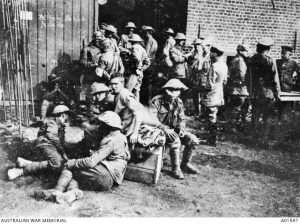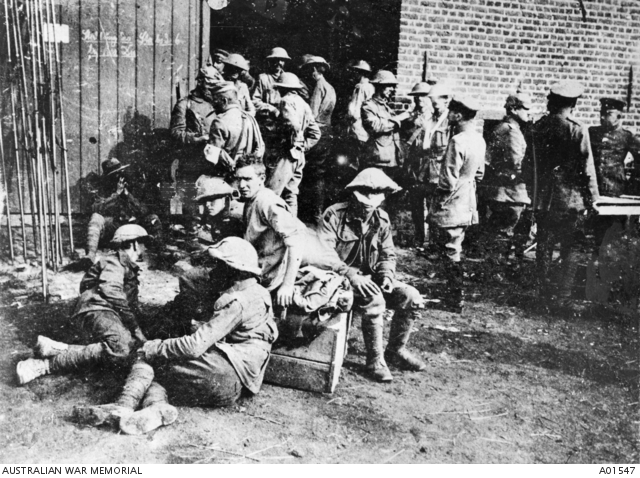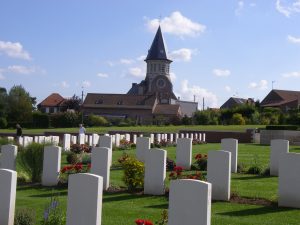
Australian prisoners of war at the German collecting station following the Battle of Fromelles, France, 20 July 1916. Image courtesy Australian War Memorial.
The Battle of Fromelles was fought on the Western Front in France on 19 and 20 July 1916. It was the first time that Australian troops were engaged in major battle on the Western Front, and the first time that they encountered industrial warfare on an unprecedented scale.
The attack on Fromelles – also known as the Battle of Fleurbaix – was the initiative of the British General Sir Richard Haking. The intention of the attack was two-fold: to capture enemy positions on higher ground surrounding the village, and to draw German reinforcements away from the Battle of the Somme 80km to the south.
The battle began with a British artillery barrage at 11am on Wednesday 19 July 1916. At 6pm soldiers of the Australian 5th Division, under the command of the Australian Major-General James Whiteside McCay, spearheaded the assault, advancing across no-man’s-land towards the German salient of Sugar Loaf.
They met with an intense barrage of German artillery and machine gun fire; easy targets on the flat and open terrain in the summer daylight. Tenuous footholds were made into German territory and a deadly, see-sawing battle that saw vicious hand-to-hand fighting raged throughout the night. By daylight the Australians had been forced back to their original positions and, at 8am, the order to withdraw was given.
After 1½ days fighting almost half of the Australian troops had been killed or wounded. The Australian 5th Division suffered 5,533 casualties, including 1,917 men killed – the worst 24 hours in Australian military history. A further 400 men were taken prisoner of war. By comparison, British casualties numbered 1,547, and German 1,500.
German soldiers buried many of the Australian dead in unmarked pits after the battle. In May 2008 six mass graves were identified on the edge of Pheasant Wood near the village of Fromelles; they contained the remains of 250 British and Australian soldiers. The Commonwealth War Graves Commission re-interred the remains on 19 July 2010 in a solemn ceremony, with full military honours, at the newly created Fromelles Military Cemetery.
The remains of a further 410 Australian soldiers are buried at nearby VC Corner Cemetery. Beyond the cemetery is a memorial wall commemorating by name the 1,299 Australians who died in the Battle of Fromelles and who have no known grave. The inscription reads:
In honour of the 410 unknown Australian soldiers here buried, who were among the 1,299 Officers, Non-Commissioned Officers and Men of the Australian Imperial Force, killed in the Attack on Fromelles, July 19th and 20th, 1916.
The battle at Fromelles was ill-conceived and poorly executed. Almost 2,000 Australians had been sacrificed for no reason. There had been no military gain and the battle had no effect whatsoever on Germany’s ability to send reinforcements to the Somme.
Commander of the Australian 15th Brigade, Brigadier General Harold Edward ‘Pompey’ Elliott, later declared:
Practically all my best officers, the Anzac men who helped to build up my Brigade, are dead. I presume there was some plan at the back of the attack but it is difficult to know what it was.
Five men from the Orange district were killed in action during the Battle of Fromelles: Cecil Parker Ashdown, Charles William Gordon Conroy, Charles William Murray, Arnold Needham and Albert Leslie Singleton.
Two others – George Alfred Blunt and Keith Whitmee (Barney) Davis – later died of wounds received during the battle.
One man, Arthur McKell, was taken prisoner during the battle. He was repatriated to England in November 1918.


